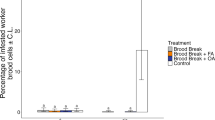Play all audios:

ABSTRACT DRASTIC recommendations regarding the disinfection or destruction of combs, hives, and appliances which have come in contact with bees infected by Isle of Wight disease have been
made by the Board of Agriculture, and were repeated in an article in NATURE of March, 2 (p. 7). The recommendations are founded upon the idea of the infectiousness of the disease, and are
intimately connected with the recognition pf the, protozoon _Nosema apis_ as the cause of the disease and with the knowledge of the ease by which this parasite can be disseminated by
infected bees. On account of the practical importance of the subject, I would direct attention to the results of experiments bearing upon these points, carried out by Mr. J. Anderson and Dr,
J. Renaie, of the North of Scotland, College of Agriculture and University of Aberdeen, respectively, and communicated at a recent meeting of the Royal Physical Society. As an account of
the observations and experiments, which were numerous and detailed, will appear in the next part of the Proc. Roy. Physical Soc., an indication of their bearing is all that is necessary for
the present. Access through your institution Buy or subscribe This is a preview of subscription content, access via your institution ACCESS OPTIONS Access through your institution Subscribe
to this journal Receive 51 print issues and online access $199.00 per year only $3.90 per issue Learn more Buy this article * Purchase on SpringerLink * Instant access to full article PDF
Buy now Prices may be subject to local taxes which are calculated during checkout ADDITIONAL ACCESS OPTIONS: * Log in * Learn about institutional subscriptions * Read our FAQs * Contact
customer support SIMILAR CONTENT BEING VIEWED BY OTHERS MANAGING THE PARASITIC HONEY BEE MITE _TROPILAELAPS MERCEDESAE_ THROUGH COMBINED CULTURAL AND CHEMICAL CONTROL METHODS Article Open
access 27 October 2024 POSSIBLE INTERFERENCE OF _BACILLUS THURINGIENSIS_ IN THE SURVIVAL AND BEHAVIOR OF AFRICANIZED HONEY BEES (_APIS MELLIFERA_) Article Open access 10 February 2021 A TALE
OF TWO PARASITES: RESPONSES OF HONEY BEES INFECTED WITH _NOSEMA CERANAE_ AND _LOTMARIA PASSIM_ Article Open access 18 December 2023 AUTHOR INFORMATION AUTHORS AND AFFILIATIONS * Hon.
Secretary, Royal Physical Society, Edinburgh JAMES RITCHIE Authors * JAMES RITCHIE View author publications You can also search for this author inPubMed Google Scholar RIGHTS AND PERMISSIONS
Reprints and permissions ABOUT THIS ARTICLE CITE THIS ARTICLE RITCHIE, J. Isle of Wight Disease in Bees. _Nature_ 97, 160–161 (1916). https://doi.org/10.1038/097160c0 Download citation *
Issue Date: 20 April 1916 * DOI: https://doi.org/10.1038/097160c0 SHARE THIS ARTICLE Anyone you share the following link with will be able to read this content: Get shareable link Sorry, a
shareable link is not currently available for this article. Copy to clipboard Provided by the Springer Nature SharedIt content-sharing initiative
